In 207 B.C., the Qin Dynasty ended under the attack of Xiang Yu, Liu Bang, and other forces. After the four-year-long Chu-Han War, Liu Bang finally defeated Xiang Yu in 202 B.C. and set up the Han Dynasty in Chang'an (today's Xi'an). In Chinese history, Han consisted of two dynasties: the Western Han (206 BC - 24 A.D.) and the Eastern Han (25 - 220). During this period, there were 27 emperors on the throne. Many were excellent, contributing to the country's prosperity like Emperors Gaozu, Wen, Jing, and Wu. Therefore, the Han Dynasty was a world power at that time. The literature, arts, culture, and technology in the era achieved unparalleled successes. With the increase of power, the Central Plains people began to call themselves proudly as "Han people" instead of "Qin people." Some of the achievements at that time still have an impact on Chinese people today.
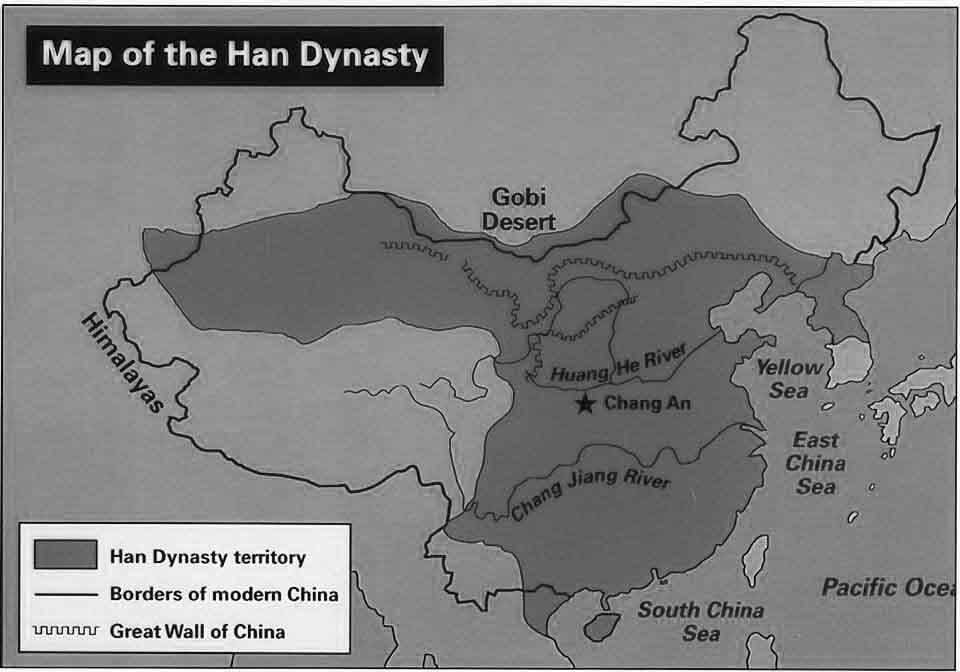
Han Dynasty Map
|
Order |
Name |
Reign Period |
Brief Introduction |
Mausoleum |
|
Emperors of Western Han Dynasty |
||||
|
1 |
Han Gaozu Liu Bang |
202 B.C. - 195 B.C |
Liu Bang (256 - 195 B.C.) came from a peasant family. He joined the uprisings against the Qin Dynasty's tyrannic rule and competed with the Western King Chu. After the 4-year long hard-won victory, Liu Bang successfully established the Han Dynasty in 202 and bestowed many vassals. |
Chang Mausoleum in Xianyang (28km from Xian) |
|
2 |
Han Huidi Liu Ying |
195 B.C. - 188 B.C |
Liu Ying (211 - 188 B.C.), the eldest son of Gaozu Emperor, was weak and controlled by his mother, Lv Zhi, during his reign. |
An Mausoleum in Xianyang (32km from Xian) |
|
3 |
Former Shaodi Liu Gong |
188 B.C. - 184 B.C |
Liu Gong was chosen by Lv Zhi as a puppet emperor. |
Hasn’t found. |
|
4 |
Latter Shaodi Liu Hong |
184 B.C. - 180 B.C |
Liu Hong was also a puppet emperor chosen by Lv Zhi. |
Hasn’t found. |
|
5 |
Han Wendi Liu Heng |
180 B.C. - 157 B.C |
Liu Heng (202 - 157 B.C.), the fourth son of Liu Bang, weakened the power of vassal states, lowered peasants' taxation, and promoted the restoration and development of the social economy. |
Ba Mausoleum in Xian |
|
6 |
Han Jingdi Liu Qi |
157 B.C. - 141 B.C |
Liu Qi (188 - 141 B.C.), son of Wendi, suppressed the revolt of seven vassals, strengthened the centralized governance, and continued to implement the previous policies, progressing the Reigns of Wen and Jing. |
Yang Mausoleum in Xian |
|
7 |
Han Wudi Liu Che |
141 B.C. - 87 B.C |
Liu Che (157 - 87 B.C.), son of Jingdi, continued to enhance the centralized ruling, forced the northern nomads to the deep north, and opened up the land Silk Road. Han Dynasty reached the most prosperous time during his ruling. |
Mao Mausoleum in Xianyang (50km from Xian) |
|
8 |
Han Zhaodi Liu Fuling |
87 B.C. - 74 B.C |
Liu Fuling (95 - 74 B.C.), son of Wudi, continued his father’s course and ruled peacefully. |
Ping Mausoleum in Xianyang (40km from Xian) |
|
9 |
Han Xuandi Liu Xun |
74 B.C. - 49 B.C |
Liu Xun (91 - 49 B.C.), great-grandson of Wudi, further prospered the society. |
Du Mausoleum in Xian |
|
10 |
Han Yuandi Liu Shi |
49 B.C. - 33 B.C |
Liu Shi (75 - 33 B.C.), son of Xuandi, appointed his wife’s kin to the important positions, which laid danger for the future and made an alliance with northern nomads by marrying Wang Zhaojun. |
Wei Mausoleum in Xianyang (40km from Xian) |
|
11 |
Han Chengdi Liu Ao |
33 B.C. - 7 B.C |
Liu Ao (52 - 7 B.C.), son of Yuandi, winked at his mother's relatives to grasp the power and indulged himself in entertainment every day. As a result, Western Han Dynasty became declining. |
Yan Mausoleum in Xianyang (32km from Xian) |
|
12 |
Han Aidi Liu Xin |
7 B.C. - 1 B.C |
Liu Xin (26 - 1 B.C.), grandson of Yuandi, pampered Dong Xuan and Wang Mang to rule for him. During his reign, the social contradictions heated and escalated. |
Yi Mausoleum in Xianyang (50km from Xian) |
|
13 |
Han Pingdi Liu Kan |
1 B.C. - 6 A.D |
Liu Kan (9 - 5 B.C.), brother of Aidi, was poisoned to death by Wang Mang. |
|
|
14 |
Ruzi |
6 - 8 A.D |
Ruzi Ying (5 - 25 A.D.) was also killed by Wang Mang. |
|
|
Xin Dynasty (9 - 23) |
||||
|
15 |
Wang Mang |
9 - 23 A.D |
Wang Mang (45 B.C. - 23 A.D.) is the nephew of the queen of Emperor Xiaoyuan. He was modest, wise, and authoritative among the court. In the late Western Han Dynasty, the social contradictions intensified unprecedentedly, and Wang Mang was considered the one who can save the country. In 8 AD, Wang Mang usurped the throne, established the Xin Dynasty, and performed a series of reforms. He was considered an illegitimate ruler by later generations. |
Huayin City, Shaanxi |
|
Eastern Han Dynasty (25 - 220 A.D.) |
||||
|
16 |
Guangwu Di Liu Xiu |
25 - 57 A.D |
Liu Xiu (6 B.C. - 57 A.D.) was the ninth-generation grandson of Gaozu Liu Bang; he defeated the Wang Mang’s army and reestablished the Han Dynasty, which is historically called the Eastern Han Dynasty. |
Yuan Mausoleum in Mengjin County (40km from Luoyang) |
|
17 |
Ming Di Liu Zhuang |
57 - 75 A.D |
Liu Zhuang (28 - 75) was the fourth son of Liu Xiu; he ruled wisely and peacefully. |
Xianjie Mausoleum in Luoyang, Henan |
|
18 |
Zhang Di Liu Da |
75 - 88 A.D |
Liu Da (58 -88) was the fifth son of Xiaoming Emperor. He revered Confucianism and sent Ban Chao to expedite western areas and drove Huns to the far north. |
Jing Mausoleum in Luoyang, Henan |
|
19 |
He Di Liu Zhao |
88 - 106 |
Liu Zhao (79 - 105), fourth son of Xiaozhang Di, successfully expelled his mother queen's power and ruled personally. |
Shen Mausoleum in Yanshi, Henan |
|
20 |
Shang Di Liu Long |
106 |
Liu Long (105-106), the youngest son of Xiaohe Di, was enthroned at one month old and died at eight months old. |
Kang Mausoleum in Yanshi, Henan |
|
21 |
An Di Liu Hu |
106 - 125 |
Liu Hu (94 - 125) was the grandson of Xiao Zhangdi. During his reign, his queen's mother held power and the social contradictions began to intensify. |
Gong Mausoleum in Luoyang |
|
22 |
Shun Di Liu Bao |
125 - 144 |
Liu Bao (114 - 144) was the son of Xiao Andi, and he was enthroned by the eunuch, who later ruled on behalf of him. The politics became dark. |
Xian Mausoleum in Luoyang, Henan |
|
23 |
Chong Di Liu Bing |
144 - 145 |
Liu Bing (143 - 145) was the son of Xiaoshun Di; he died at three years old. |
Huai Mausoleum in Luoyang, Henan |
|
24 |
Zhi Di Liu Zuan |
145 - 146 |
Liu Zuan (138 - 146), the great-grandson of Xiaozhang Di, was poisoned by general Liang Yi. |
Jing Mausoleum in Yanshi, Henan |
|
25 |
Huan Di Liu Zhi |
146 - 168 |
Liu Zhi (132 - 167) was the brother of Xiaozhi Di. During his ruling, the eunuchs were very powerful. |
Xuan Mausoleum in Luoyang, Henan |
|
26 |
Ling Di Liu Hong |
168 - 189 |
Liu Hong (156 - 189) was the great great grandson of Xiaozhang Di. During his ruling, the court was very corrupt, and social contradictions escalated more. In 184, a large scale of uprisings broke out. |
Wen Mausoleum in Menjin County, Luoyang, Henan |
|
27 |
Xian Di Liu Xie |
189 - 220 |
Liu Xie (1981 - 234), son of Xiaoling Di, ascended the throne at 9 and was manipulated by Dong Zhuo first and Cao Cao later. In 220, he was coerced to abdicate and degraded as Duke Shanyang. |
Shan Mausoleum in Xiuwu County, Jiaozuo, Henan |
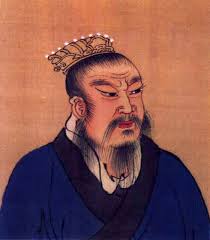
In the late Qin Dynasty, multiple revolts broke out throughout the country. Two leading forces were led by Xiang Yu and Liu Bang, and between them, Xiang Yu's power was stronger. Xiang Yu claimed himself the King of Western Chu and bestowed Liu Bang, the King of Hanzhong. They made a pact that whoever broke into Xianyang (capital of Qin Dynasty) first would rule eventually. Liu Bang successfully made to Xianyang first and had a determining victory over Xiang Yu and his army in Gaixia (today’s Lingbi, Anhui province). In 202, Liu Bang ascended the throne and built the Han Dynasty, which is historically called the Western Han Dynasty.
Emperor Wu of Han Liu Che (141-87BC) was considered the greatest emperor of the Han Dynasty. He ascended the throne at the age of 13 and performed a series of policies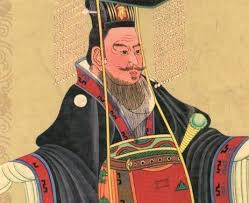 to strengthen the centralization. In terms of politics, Liu Che instituted a system whereby the descendants of the kings granted by Han Gaozu can only inherit parts of the kingdoms. In terms of economy, he imposed a lot of restrictions on merchants and invigorated the agricultural development. In terms of culture, Wudi appointed the Confucian scholar Dong Zhongshu and made the Confucian theory state ideology. In terms of military, the emperor set forth a central standing army, enforced the frontier fortress, strengthened the defense against Huns, and expanded the territory of the Han Dynasty to the hinderland of Asia. Besides, Emperor Wu also sent ambassadors to the western world, pioneered the Silk Road, and promoted communication between the orient and the west.
to strengthen the centralization. In terms of politics, Liu Che instituted a system whereby the descendants of the kings granted by Han Gaozu can only inherit parts of the kingdoms. In terms of economy, he imposed a lot of restrictions on merchants and invigorated the agricultural development. In terms of culture, Wudi appointed the Confucian scholar Dong Zhongshu and made the Confucian theory state ideology. In terms of military, the emperor set forth a central standing army, enforced the frontier fortress, strengthened the defense against Huns, and expanded the territory of the Han Dynasty to the hinderland of Asia. Besides, Emperor Wu also sent ambassadors to the western world, pioneered the Silk Road, and promoted communication between the orient and the west.
202 B.C: establishment of Han Dynasty;
202 - 196 B.C: elimination of vassal kings;
196 - 180 B.C: dictatorship of Lv Zhi;
154 B.C: rebellion of eight princes;
180 - 141 B.C: Great Reigns of Emperor Wen and Emperor Jing;
141 - 87 B.C: Flourishing Period of Emperor Wu’s Reign and the decisive victory against Huns.
140 B.C: Zhang Jian was sent on a diplomatic mission to the west.
127 B.C: Han Great Wall began to be built.
87 - 48 B.C: Reign of Emperor Zhao and Emperor Xuan.
9 A.D: Wang Mang abolished the emperor and established the Xin Dynasty.
The collapse of the Western Han Dynasty seemingly resulted from the potent power of the relatives of queens. The fact is that the Western Han Dynasty declined due to the collapse of its economic system. The first and biggest problem was the private ownership of land. In the late Western Han Dynasty, the land annexation was very severe. Secondly, the abnormal development of the industry and commerce made politics more corrupt. Lastly, the state-run salt, mining, and smelting business exploited many peasants, leaving fewer people to engage in farming.
In the year 25, Liu Xiu, a descendant of Western Han royalty, seized the power of uprisings, defeated Wang Mang, and established the Eastern Han Dynasty, setting the capital in Luoyang. Upon establishment, Liu Xiu awarded ministers and relatives generously, which later caused the local warlords' expansion.
After the middle period of the Eastern Han, most of the emperors were juveniles, and the real royal power was held by distant relatives and eunuchs. This caused darkness and corruption of politics in the later period. Besides, when the peasant uprisings broke out in the late Eastern Han Dynasty, the central government didn’t send armies to suppress. Instead, the local landlords and bureaucrats set up their forces to control the uprisings to maintain their interests. They even privatized the original national armies for their own sake. Therefore, the central court was weakened.
With the Eastern Han Dynasty ended, China officially entered the Three Kingdoms Period. Cao Cao established the Wei Kingdom regime in the north, Liu Bei established the Shu Kingdom in the southwest, and Sun Quan set up the Wu Kingdom in the southeast. In 220, Cao Pi (son of Cao Cao) claimed himself emperor in Luoyang, and one year later, Liu Bei declared himself emperor in Chengdu. In 229, Sun Quan also proclaimed himself the emperor. In 263, Wei Kingdom annihilated the Shu Kingdom. Two years later, Sima Zhao (a powerful minister of the Wei Kingdom) usurped the throne and became the emperor, establishing the Jin Dynasty (Western Jin Dynasty). In 280, the Jin Dynasty destroyed the Wu Kingdom and unified the whole China.
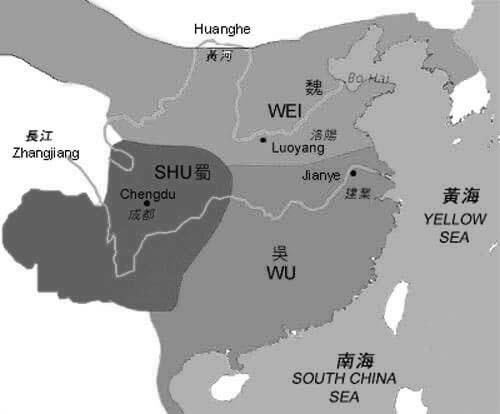
The tyranny and turmoil at the end of the Qin Dynasty had left a poor economic situation for the early Han Dynasty. The rulers of the early Han Dynasty learned the lessons from Qin's extermination and applied the rehabilitation policy. During the period of Emperor Wendi and Emperor Jingdi, the economy recovered, and society stabilized, and the first peaceful period in ancient Chinese history began. Based on this, Emperor Wudi displayed his great talents for further exploitation and development and brought the Western Han to the culmination.
Rehabilitation was practiced with policies of reducing the taxation and corvee and awarding production. Emperor Gaozu promulgated a range of favored measures including releasing soldiers to farming, offering amnesty and enlisting refugees, freeing servants and maids to suitable places, reducing and exempting corvee, and setting the land to 1/15, resulting in a mass movement of the population back to agricultural production. Emperor Wendi applied agricultural and textile development to evaluate local officials and reduced the land rent to 1/30. These measures pushed the rapid recovery and development of agriculture. Emperor Wudi further promoted salt and iron's official monopoly, collected industrial and commercial taxes, established buffer institutions to control prices, unified the currency, prohibited private coin casting, and implemented other financial reforms. Thus, the country firmly grasped the economy and increased financial income, laying a solid economic foundation for a grand unified empire.
1.Paper-making. 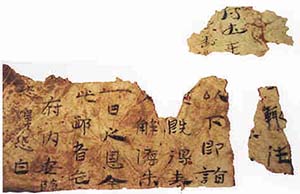
2.Porcelain making.
3.Development of textile technology and the wide use of silk.
4.Smelting technology.
5.Chinese medicine. Famous physicians like Hua Tuo and Zhang Zhongjing appeared.
6.Architectural standard and regulation appeared.
Han Dynasty did continue to build the Great Wall. Han Dynasty Great Wall was mainly built during the reign of Emperor Wudi. There are two kinds of Great Walls at that time. The first kind was to reinforce the Qin Dynasty Great Wall and Yan Great Wall. The Qin Great Wall was mainly restored to prevent the invasion of Huns, protect the development of western regions, and improve the communication between the Han Dynasty and the west.
In comparison, the Yan Great Wall was mainly in Liaoning province. Han Wudi also ordered the outer Great Wall to be built outside the Wuyuan Jun (current Jiuyuan District of Baotou city in Inner Mongolia). There are two existing sections. The northern line of the Great Wall started from Wuchuan County (north of Hohhot, Inner Mongolia), passed Guyang County, Darhan Muminggan Liahheqi, and stretched northwest to South Gobi province (a province of today’s Mongolia) until Mount Hurhura, totaling 527km. While the Great Wall's southern line started from the Wuchuan County (north of Hohhot), passed Urat and stretched into today's Mongolia, then went southwards to Ejin Banner, and connected the Juyan Frontier.
In 134 B.C., Emperor Wu of the Han Dynasty adopted Dong Zhongshu's advice and established the dominating position of Confucianism. The fact is that this ideology is coincident with the ruling class and conducive for enhancing the centralized governing. In the early ruling of the Han Dynasty, the country had undergone a lot of damages. People needed time to recover. While in Wudi’s reign, the society and economy already rejuvenated. Plus, Emperor Wu himself had a great craving for greatness and success. Therefore, he adopted Confucianism to rule the country and strengthen the centralized governance and unify the public's ideology. This thinking also helped to form a mainstream thinking of grand unification and significantly impacted the neighboring minorities, publicizing the legitimacy of the Han emperor's ruling.
Day Trip to Hanyangling Museum Cave Dwelling and Terracotta Army
2 Days Heritage Tour to Terracotta Warriors and Jingdi's Tomb
Copyright © 2019 Lily Sun China Tours International, Inc. Terms &conditions | Privacy Policy | Sitemap